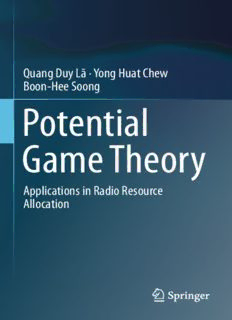
Potential Game Theory: Applications in Radio Resource Allocation PDF
Preview Potential Game Theory: Applications in Radio Resource Allocation
Quang Duy Lã · Yong Huat Chew Boon-Hee Soong Potential Game Theory Applications in Radio Resource Allocation Potential Game Theory Quang Duy LaQ • Yong Huat Chew Boon-Hee Soong Potential Game Theory Applications in Radio Resource Allocation 123 QuangDuyLaQ YongHuatChew TemasekLaboratories CognitiveCommunicationsTechnology SingaporeUniversityofTechnology Department andDesign InstituteofInfocommResearch(I2R), Singapore,Singapore A*STAR Singapore,Singapore Boon-HeeSoong SchoolofElectricalandElectronic Engineering NanyangTechnologicalUniversity Singapore,Singapore ISBN978-3-319-30867-8 ISBN978-3-319-30869-2 (eBook) DOI10.1007/978-3-319-30869-2 LibraryofCongressControlNumber:2016938420 ©SpringerInternationalPublishingSwitzerland2016 Thisworkissubjecttocopyright.AllrightsarereservedbythePublisher,whetherthewholeorpartof thematerialisconcerned,specificallytherightsoftranslation,reprinting,reuseofillustrations,recitation, broadcasting,reproductiononmicrofilmsorinanyotherphysicalway,andtransmissionorinformation storageandretrieval,electronicadaptation,computersoftware,orbysimilarordissimilarmethodology nowknownorhereafterdeveloped. Theuseofgeneraldescriptivenames,registerednames,trademarks,servicemarks,etc.inthispublication doesnotimply,evenintheabsenceofaspecificstatement,thatsuchnamesareexemptfromtherelevant protectivelawsandregulationsandthereforefreeforgeneraluse. Thepublisher,theauthorsandtheeditorsaresafetoassumethattheadviceandinformationinthisbook arebelievedtobetrueandaccurateatthedateofpublication.Neitherthepublishernortheauthorsor theeditorsgiveawarranty,expressorimplied,withrespecttothematerialcontainedhereinorforany errorsoromissionsthatmayhavebeenmade. Printedonacid-freepaper ThisSpringerimprintispublishedbySpringerNature TheregisteredcompanyisSpringerInternationalPublishingAGSwitzerland Tomyparentsandsister—Q.D.Lã Tomyparents,eldersister(inmemory), sisters,wife,andchildren—Y.H.Chew Tomyparents,wife,andchildren—B.-H. Soong Preface Gametheoryistheformalstudiesofdecision-makingamongmultipleautonomous playerswhohavecommonorconflictinginterestsandwhoseinteractionsinfluence theoutcomesobtainedbyeachparticipant.Ithasfounditsapplicationsintheareas oftelecommunicationengineeringsincetheearly1990s,forsolvingproblemssuch as flow control and routing. In recent years, game-theoretical approach to radio resource allocation is one of the most extensively investigated research topics in wireless communications. A significant number of scientific papers and books, as well as special journal issues (e.g., the IEEE Journal on Selected Areas in Communications and the IEEE Journal on Selected Topics in Signal Processing) havebeendedicatedtothistopic. In some interactive scenarios involving selfish decentralized individuals, game theoryhelpsusformulateanalyticalmodelssothatwecanexaminethepossiblefinal outcomesandstudythestabilityconditionsoftheseoutcomes.Thisisimportantin devising good strategies, which we ultimately hope will lead the system to these stable,efficientstatesatwhichtheoverallperformanceisimprovedandsustainable comparedtoarandomized,uncontrolledoperatingstate.Tothisend,itisessential to emphasize the need to establish the existence of Nash equilibria in wireless communication games, one of which will be chosen as the final stable operating point of the system. The system exhibits a preferable and desirable property, if only one unique Nash equilibrium exists and any initially adopted strategy profile of players is able to converge to this Nash equilibrium by applying some iterative dynamics. Existence and convergence of Nash equilibrium do not always apply to any arbitrary utility functions and strategy sets. However, there are special types of games,includingpotentialgames,whereatleastapure-strategyNashequilibrium isguaranteedtoexistandcanbereachedwithcertainclassesoflearningdynamics such as the best responses. In a potential game formulation, one can identify a specialfunctioncalledthepotentialfunction,whichchangesvalueswheneverthere isachangeintheutilityofanysingleplayerduetohis/herownstrategydeviation, accordingtosomepredefinedrelationships.Assuch,thegame’sequilibriacanoften be associated with the optimum points of this potential function. Potential games vii viii Preface are first studied by Monderer and Shapley [11]. Due to their desirable properties, they have been adopted to model radio resource allocation problems. Despite the promisingnumberofapplicationsinseveralwirelesscommunicationsproblems,it seemsthatthemeanstoformulateaproblemasapotentialgameisstillvastlydone through the process of trials and errors, with most applications being limited to a fewknown utilityfunctions.Infact,therelacks aunifyingframeworkinorderfor us to gain an in-depth insight in order to better exploit this very useful technique. For example, the overarching question of whether or not there is a systematic methodtoidentifyandtodefinethepotentialfunctionofagameisstillunanswered. Alternatively,howonecangeneralizeandestablishnewpotentialgamemodelsfor existingpracticalproblemsisanothercomplicatedandchallengingproblem.Tothe bestoftheauthors’knowledge,therearedozensoftextbooksthatpresentexcellent accounts of the use of game theory for wireless communications. Nevertheless, potential games often only receive a one-chapter treatment at best. No books or monographsareavailabletoaddresstheaforementionedconcerns. Inthismonograph,weattemptatacompletetreatmentofpotentialgametheory and its applications in radio resource management for wireless communications systemsandnetworking.Wehopetopavethewaytomoreextensiveandrigorous researchfindingsonatopicwhosecapacityforpracticalapplicationsispotentially huge but yet not fully exploited. First and foremost, a generalized and rigorous mathematical framework on potential games will be presented. Consequently, we willdiscussnewaswellasexistingfindingsontheformulationofpotentialgames andtheirapplicationsinsolvingavarietyofwirelesscommunicationsproblems. Themonographiscomprisedoffivechaptersandisdividedintotwoparts: (cid:129) InPartI—Theory,thepurposeistointroducethenecessarybackground,aswell asthenotationsandconceptsusedingametheory.Inparticular,wedocumentour studiesofaclassofgamesknownaspotentialgames,whichhavefounduseful applicationsinthecontextofradioresourceallocation.Thematerialscoveredin Part I will lay the fundamentals for the actual applications presented in Part II. PartIconsistsoftwochapters: – Chapter 1 serves as a concise introductory text to game theory. It reviews the most elemental concepts and building blocks in game theory. We put an emphasisontheuseofiterativedecisiondynamicsinmyopiccomputationof Nashequilibria,whichisaprocessoftenemployedinpracticalapplications. The discussion is facilitated with a series of toy examples in order to have a betterunderstandingoftheabstractconcepts. – Chapter 2 is the focal point of the monograph where theoretical treatments on potential games and our contributions to the literature on this topic are presented. Besides theoretical definition and characterization, we also give a very detailed and rigorous discussion on the questions of how to identify whether a game is a potential game, how to find the corresponding potential function,andhowtoformulatetheutilityfunctionsothattheresultinggame is a potential game. The chapter is a cornerstone of the monograph, which servesasabasisforallsubsequentdiscussions. Preface ix (cid:129) Part II—Applications looks into a variety of practical problems in wireless resourceallocationwhichcanbeformulatedaspotentialgames.Inthispart,we presentourownresultsaswellassummarizeexistingrelatedworks.Itincludes threechapters: – Chapter 3 uses game-theoretical approaches to achieve fair and efficient spectrum access schemes for the distributed OFDMA network consisting of transmit-receivepairswhichexploitsspatialfrequencyreuse.Wediscusshow apotentialgamecanbeformulated,thebehaviorsofstrategydomination,and how it can be overcome, as well as an analysis of the price of anarchy. The systemperformancewhenbest-responsealgorithmisusedwillbeevaluated. – Chapter4looksatthesubcarrierallocationproblemforadownlinkmulticell multiuser OFDMA network where a potential game is also formulated. We proposeouriterativealgorithmforobtainingtheNashequilibriaandaddress severalperformanceissuessuchasfairnessforedge-usersaswellaswhenthe systemisoverloaded. Numerical results show the improvement inefficiency andfairnessofthisapproachoverexistingschemes. – Chapter5givesasummaryofexistingapproachesthatapplypotentialgames in solving wireless communications and networking problems, focusing on theformulationsusingexactpotentialgamesandpseudo-potentialgames.A non-exhaustivelistofselectedapplicationsdiscussedinthischapterincludes Menonetal.[9],Buzzietal.[2],Neeletal.[12],Babadietal.[1],Scutarietal. [14], Perlaza et al. [13], Mertikopoulos et al. [10], Xu et al. [16], Heikkinen [3],andXiaoetal.[15],tonameafew. Thismonographishelpfulforengineeringstudentsatthegraduateandadvanced undergraduate levels to learn and understand the fundamentals of potential game theory. It is also intended to introduce researchers and practitioners on how this theory can be used to solve the practical radio resource allocation problems. Researchers, scientists, and engineers in the fields of telecommunication, wireless communications, computer sciences, and others will certainly benefit from the contentsofthebook. Chapters 3 and 4 of this monograph make use of materials that have been published in the authors’ earlier papers [5–8], as well as the first author’s Ph.D. thesis[4]. Singapore,Singapore QuangDuyLã 2015 YongHuatChew Boon-HeeSoong References 1.BabadiB,TarokhV(2010)Gadia:agreedyasynchronousdistributedinterferenceavoidance algorithm.IEEETransInfTheory56(12):6228–6252
Description: